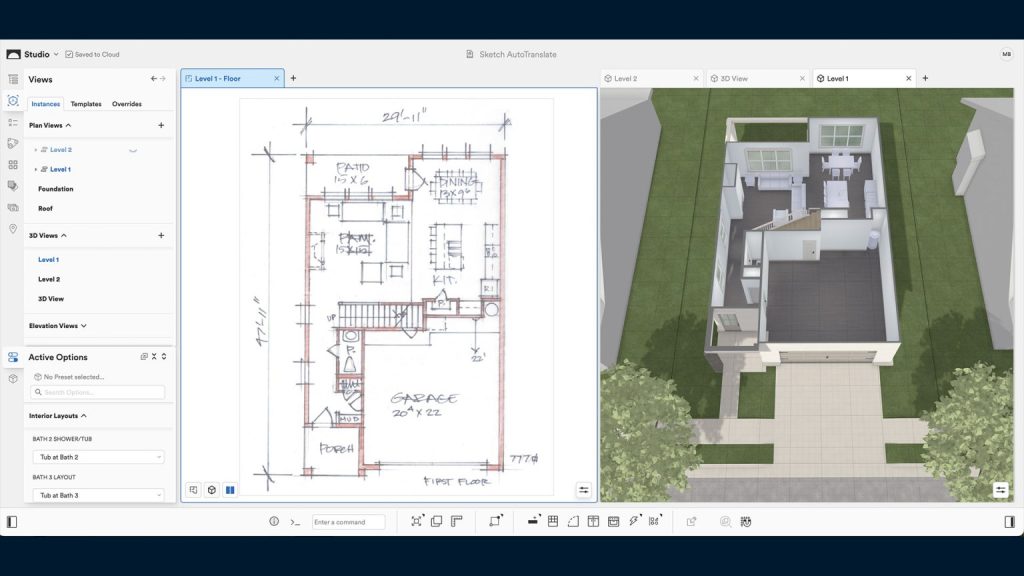In the emerging world of BIM 2.0, there will be generic new BIM tools and expert systems, dedicated to certain building types. Higharc is a cloud-based design solution for US timber frame housing. The company recently demonstrated impressive new AI capabilities
While AI is in full hype cycle and not a day passes without some grandiose AI claim, there are some press releases that raise the wizzened eyebrows at AEC Magazine HQ. North Carolina-based start-up, Higharc, has demonstrated a new AI capability which can automatically convert 2D hand sketches to 3D BIM models within its dedicated housing design system. This type of capability is something that several generic BIM developers are currently exploring in R&D.
Higharc AI, currently in beta, uses visual intelligence to auto-detect room boundaries and wall types by analysing architectural features sketched in plan. In a matter of minutes, the software then creates a correlated model comprising all the essential 3D elements that were identified in the drawing – doors, windows, and fixtures.
Find this article plus many more in the March / April 2025 Edition of AEC Magazine
👉 Subscribe FREE here 👈
Everything is fully integrated with Higharc’s existing auto-
drafting, estimating, and sales tools, so that construction documents, take-offs, and marketing collateral can be automatically generated once the design work is complete.
In one of the demonstrations we have seen, a 2D sketch of a second floor is imported, analysed and then automatically generates all the sketched rooms and doors, with interior and exterior walls and windows. The AI generated layout even means the roof design adapts accordingly. Higharc AI is now available via a beta program to select customers.
Marc Minor, CEO and co-founder of Higharc explains the driving force behind Higharc AI. “Every year, designers across the US waste weeks or months in decades-old CAD software just to get to a usable 3D model for a home,” he says.
“Higharc AI changes that. For the first time, generative AI has been successfully applied to BIM, eliminating the gap between hand sketches and web-based 3D models. We’re working to radically accelerate the home design process so that better homes can be built more affordably.”
AI demo
In the short video provided by Higharc, we can see a hand drawn sketch imported into the Autolayout tool. The sketch is a plan view of a second floor, with bedrooms, bathrooms and stairs with walls, doors and windows indicated. There are some rough area dimensions and handwritten notes, denoting room allocation type. The image is then analysed. The result is an opaque overlay, with each room (space) tagged appropriately, and a confirmation of how many rooms it found. There are settings for rectangle tolerance, minimum room areas. The next phase is to generate the rooms from this space plan.
We now switch to Higharc’s real-time rendered, modelling and drawing environment, where each room is inserted on the second floor of an existing single floor residential BIM model, where walls, windows, doors and stairs are added, and materials are applied. This is simultaneously referencing an image of the sketch. The accurate BIM model has been created, combining traditional modelling with AI sketch-to-BIM generation.
What is Higharc?
Founded in 2018, Higharc develops a tailored cloud-based BIM platform, specifically designed to automate and integrate the US housing market, streamlining the whole process of design, sales, and constructing new homes.
Higharc is a service sold to home builders, that provides a tailored solution which integrates 3D parametric modelling, the auto creation of drawings, 3D visualisations, material quantities and costing estimates, related construction documents and planning permit application. AEC Magazine looked at the development back in 2022.
The company’s founders, some of which were ex-Autodesk employees, recognised that there needed to be new cloud-based BIM tools and felt the US housing market offered a greenfield opportunity, as most of the developers and construction firms in this space had completely avoided the BIM revolution, and were still tied to CAD and 2D processes. With this new concept Higharc offered construction firms easy to learn design tools, which even prospective house buyers could use to design their dream homes. As the Higharc software models every plank and timber frame, accurate quantities can be connected to ERP systems for immediate and detailed pricing for every modification to the design.
The company claims its technology enhances efficiency, accelerating a builder’s time to market by two to three times, reducing the timeline for designing and launching new plots by 75% (approximately 90 days). Higharc also claims that plan designs and updates are carried out 100 times faster than with traditional 2D CAD software.
To date, Higharc has raised $80 million and has attracted significant investment and support from firms such as Home Depot Ventures, Standard Investments, and former Autodesk CEO Carl Bass. The company has managed to gain traction in the US market and is being used to build over 40,000 homes annually, representing $19 billion in new home sales volume.
While Higharc’s first go to market was established house building firms, the company has used money raised to expand its reach to address those who want to design and build their own homes. The investment by Home Depot would also indicate that the system will integrate with the popular local building merchants, so selfbuilders can get access to more generic material supply information. The company also plans to extend the building types it can design, eventually adding retail and office to its residential origins.
In conversation
After the launch, AEC Magazine caught up with co-founder Michael Bergin and company CEO Marc Minor to dig a little deeper into the origin of the AI tool and how it’s being used. We discovered that this is probably the most useful AI introduction in any BIM solution we have seen to date, as it actually solves a real world problem – not just a nice to have of demoware.
The only reason we were able to do it, is because of what Higharc is in the first place. It’s a data-first BIM system, built for the web from the ground up
In previous conversations with Higharc, it became apparent that the company had become successful, almost too successful, as onboarding new clients to the system was a bottleneck. Obviously, every house builder has different styles and capabilities which have to be captured and encoded in Higharc but there was also the issue of digital skill sets. Typically, firms that were opting to use Higharc were not traditional BIM firms – they were housebuilders, more likely to use AutoCAD or a hand drawn sketch, than have much understanding of BIM or modelling concepts. It turns out that the AI sketch tool originated out of a need to include the non-digital, but highly experienced, house building workforce.
Mark Minor: The sketch we used to illustrate at launch is a real one, from one of our customers. We have a client, a very large builder in Texas who builds 4,000 houses per year just in Texas. They have a team of 45 or so designers and drafters, and they have a process that’s very traditional. They start on drawings boards, just sketching. They spend three months or so in conceptual design and eventually they’ll pass on their sketches to another guy who works on the computer, where he models in SketchUp, so they can do virtual prototype walk-throughs to really understand the building, the design choices, and then make changes to it.
The challenge here is that it takes a long time to go back and forth. We showed them this new AI sketch to model work we were doing, and they gave us one of their sketches for one of their homes that they’re working on. The results blew their mind. They said for them ‘this is huge’. They told us they can cut weeks or months from their conceptual stage and probably bring in more folks at the prototype walk-through stage. It’s a whole new way of interacting with design.
What makes this so special, and is the only reason we were able to do it, is because of what Higharc is in the first place. It’s a data-first BIM system, built for the web from the ground up. Because it’s data first, it means that we can not only generate a whole lot of synthetic data for training rapidly, but we really have a great target for a system like this – taking a sketch and trying to create something meaningful out of the sketch. It’s essentially trying to transform the sketch into our data model. And when you do that, you get all the other features and benefits of the Higharc system right on top of it.
Martyn Day: As the software processes the file, it seems to go through several stages. Is the first form finding?
Mark Minor: It’s not just form finding, actually, it’s mapping the rooms to particular data types. And those types carry with them all kinds of rules and settings.
Michael Bergin: At the conceptual / sketch design phase these are approximate dimensions. Once you’ve converted the rooms into Higharc, the model is extremely flexible. You can stretch all the rooms, you can scale them, and everything will replace itself and update automatically. We also have a grid resolution setting, so the sketch could even be a bubble diagram, or very rough lines, and you just set the grid resolution to be quite high, and you can still get a model out of that.
Higharc contains procedural logic, as to how windows are placed, how the foundation is placed, the relationships between the rooms. So the interaction that you see as the AI processes the sketch and makes the model, places the window, doors and the spaces between the rooms, that is all coming from rules that relate to the specifications for our builder.
Martyn Day: If doors collide, or designs do not comply with local codes, do you get alerted if you transgress some kind of design rule?
Michael Bergin: We have about 1,000 settings in Higharc that relate to the building that are to adjust for and align to issues of code compliance. When you get into automated rule checking, evaluating and digesting code rules and then applying that to the model, we have produced some exciting results in more of a research phase in that direction. There’s certainly lots of opportunities to express design logic and design rules, and we’ll continue to develop in that direction.
Mark Minor: One of the ways we use this, is we go to a home builder we want as a customer. In advance of having a sales chat, we’ll actually go to their website and screenshot one of their floor plans. We’ll pull it the AI tool and set it up as the house. We want to help folks understand that it’s not as painful and as hard as you might think. The whole BIM revolution happened in commercial, that’s kind of what’s happening in home building now. But 90% or more of all home builders use AutoCAD. We rarely come across Revit.
Martyn Day: I can see how you can bring non-digital housebuilders into the model creation side of things, where before everything would be handled by the computer expert. With this AI tool, does that mean suddenly everyone can contribute to the Higharc model?
Michael Bergin: Yes! That’s extremely important to us, bringing more of the business into the realm of the design, that’s really the core of our business. How do we bring the purchasing and the estimating user into the process of design? How do we take the operations user who’s scheduling all of the work to be done on the home into the design, because ultimately, they all have feedback. The sales people have feedback. The field team have feedback, but they’re all blocked out. They are always working through an intermediary, and perhaps through an email to a CAD operator. It goes into a backlog. We are cutting that distance between all the stakeholders in the design process and the artefact of the design has driven a lot of our development.
It’s exciting to see them engaging in the process, to see new opportunities opening up for them, which I think is broadly a great positive aspect of what’s happening with the AI revolution.
Martyn Day: You have focused on converting raster images, which is hard, as opposed to vector. But could you work with vector drawings?
Michael Bergin: While it would have been easier to use a vector representation to do the same AI conversion work, the reason that we did focus on raster was that vector would have been quite limiting. It would have blocked us out from using conceptual representations. If our customers are using a digital tool at all, they are building sketches in something like Figjam. In this early conceptual design stage, we have not seen the Rayon tools or really any of the new class of tools that the market is opening up for. Our market in US home builders tends to be the way that they’ve been doing things for some decades, and it works well for them, and we are fortunate that they have determined that Higharc is the right tool for their business.
Making it possible that the businesses process can change has required us to develop a lot of capabilities like integrating with the purchasing and estimation suite, integrating with the sales team, integrating with ERPs, really mirroring their business. Otherwise, I don’t think that we would have an excellent case for adoption of new tools in this industry.









